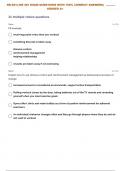Samenvatting
Samenvatting BOEK ethische en rechtsfilosofische stromingen
- Vak
- Instelling
Geslaagd in eerste zit, volledige samenvatting van het boek. Slechts 1 hoofdstuk minder uitgebreid verwerkt, maar was voldoende om te slagen. Het boek zelf kan verduidelijken waar nodig in dat hoofdstuk.
[Meer zien]











